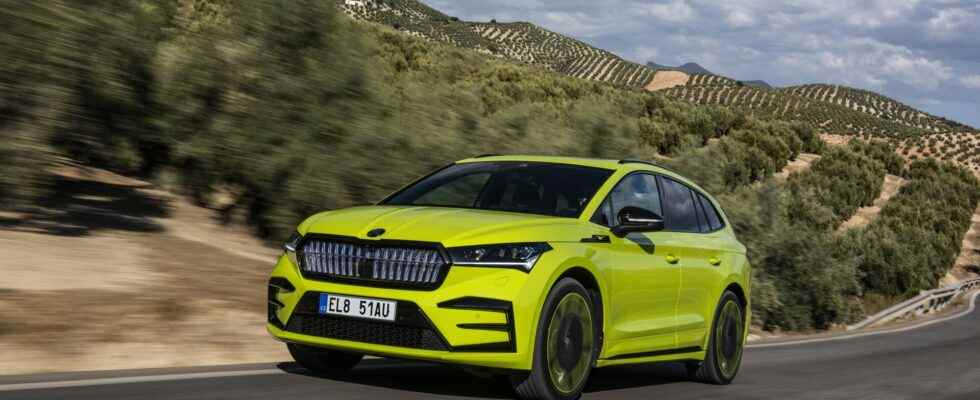What do a Volkswagen ID.4 GTX, an Audi Q4 e-tron 50 and a Skoda Enyaq RS have in common? A priori there are only common points, since these three models are based on the same architecture, the same engine and almost the same technologies.
Except that the ID.4 GTX and the Enyaq RS play the sporty card, while having 300 hp at Audi does not yet lend itself to sporting a nice S badge. , Skoda sells its Enyaq RS iV as a sports model, and despite pretty, very showy colors in the color chart like this “Green Mamba” presented in photos and attributes of sports cars, on paper, the Enyaq RS iV seems very shy. Will the big reveal take place behind the wheel?
If you’re looking for a little more wisdom, we’ve also tried the classic Skoda Enyaq iV, in 80’s trim.
Technical sheet
| Model | Skoda ENYAQ Coupe RS iV |
|---|---|
| Category | SUV |
| Power (horses) | 300 horsepower |
| Power (kw) | 220kW |
| 0 to 100 km/h | 6.5 seconds |
| Level of autonomy | 2 |
| Max speed | 180 km/h |
| Apple CarPlay | Yes |
| Android-Auto | Yes |
| Main screen size | 5.3 inch |
| Car side sockets | Type 2 Combo (CCS) |
| Length | 4650mm |
| Width | 1880mm |
| Entry-level price | €57,000 |
| Price | €48,010 |
Product sheet See the test |
Design
Let’s start with the tip of the iceberg: the look. The Skoda Enyaq RS iV is 4.65 meters long, 1.88 meters wide and 1.60 meters high. Aesthetically, as evidenced by our test version, it imposes, in particular with this green color exclusive to RS models, or its RS badges and the luminous “Crystal Face” grille as standard.
Even if the look is suggestive, it doesn’t suggest anything really sporty since it’s still an SUV and therefore there is nothing really sporty about an SUV, no matter how powerful, compared to sedans or coupes. His Cd of 0.26 allows it to fall within the category average, without however reaching the level of a Tesla Model Y with a value of 0.23.
The large rims ranging from 20 to 21 inches underline the inclinations of this model, while the chassis lowered by 15 mm at the front and 10 mm at the rear suggests that the dynamic behavior will be better compared to a more conventional Enyaq .
Habitability
Inside, as we pointed out in a previous Enyaq test, the whole is well made and has nothing to envy to a Volkswagen ID.4 or an Audi Q4 e-tron. A peak for a model hierarchically under the two aforementioned cars, but the Enyaq benefits from better quality materials and very suitable assemblies. The ergonomics are also better and the insertion of the small 5.3-inch screen under the eyes of the driver is more clever than on board the ID.4.
The semi-bucket seats are of excellent quality and provide good support for dynamic driving, without necessarily being too uncomfortable. The compromise is good overall.
Roominess is one of the best in the category, with enough space in the rear for two adults, while the boot volume ranges from 585 to 1,710 liters is in the good average of the category.

Infotainment
Infotainment within the Volkswagen Group, on their new products, frankly isn’t that. Our previous test of the Enyaq allowed us to point out that the whole thing was riddled with bugs, with a screen that became unusable at times with frozen menus.
The Enyaq RS iV features the same 13-inch touchscreen, but in our test, we did not highlight any particular problem. Skoda has integrated the new ME 3.2 software which should undoubtedly correct a lot of bugs, while it has made it possible to improve the regenerative braking system, to import a navigation route created online outside the car, or still have access to podcast and video-on-demand services.
The menus are generally well laid out and quite complete, the graphics are of good quality, while the navigation between the menus is fluid, despite some latency noted at certain times.
The Enyaq has an integrated eSIM that allows you to have permanent access to online services and to have navigation connected with real-time traffic. Voice assistance and head-up display are also included, as is induction charging of the smartphone.
Driving aids
Modern SUV obliges, the Skoda Enyaq RS iV is equipped with almost all possible – and legal – driving aids today, which in particular enabled it to obtain a 5-star Euro NCAP crash test ratingin particular thanks to the new protocol which takes into account the driving assistance systems.
Adaptive cruise control, lane keeping assistance, blind spot detection, traffic jam assistance… It’s all there, and everything works overall well as we found on our test roads in Spain, even if the system centering in the track could have been a little more finely tuned. Level 2 semi-autonomous driving is of course available.
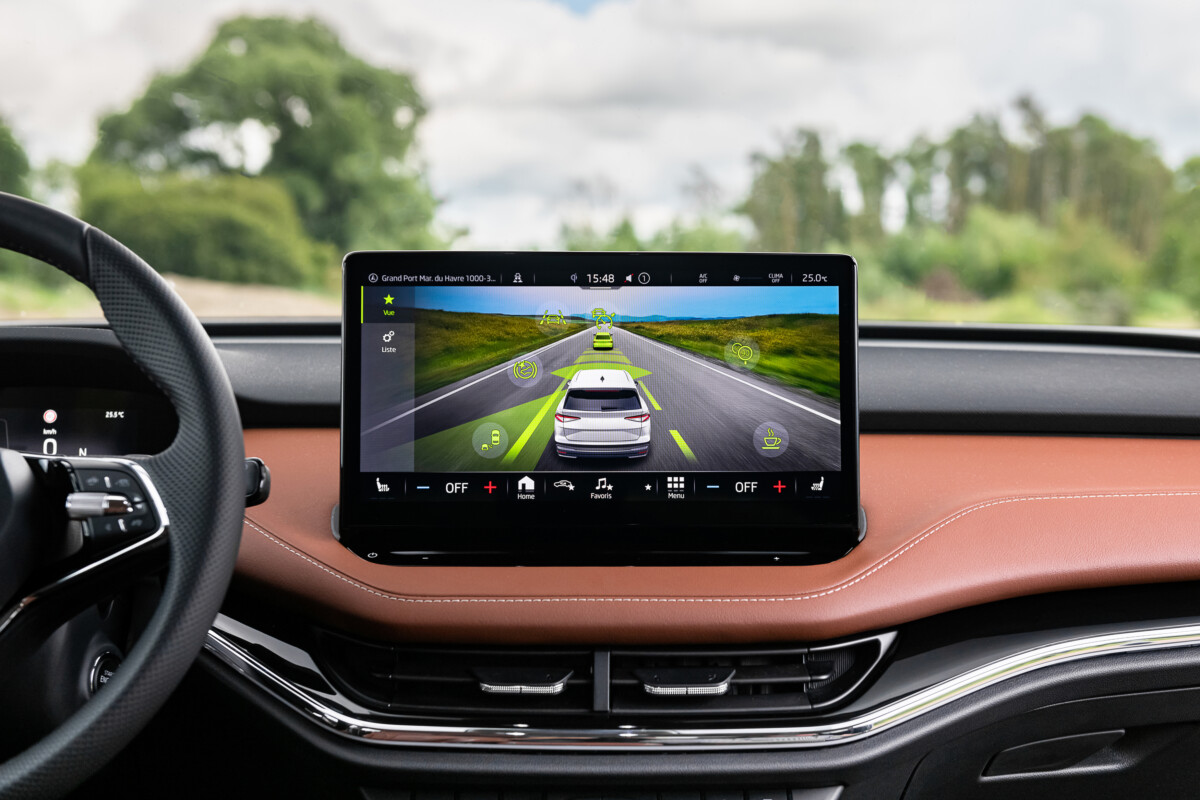
Also on the positive side, the car makes it possible to detect work areas, or plots, and to update the map by sending data (anonymously) to a central computer which is responsible for updating it regularly. navigation.
Route planner
The Skoda Enyaq RS iV also features an integrated route planner via navigation as standard. It allows you to establish a route with the charging points necessary to complete your trip. It indicates with what percentage of load you will arrive at such or such points, and the final percentage when you arrive at your destination.
You can also modulate the desired percentage on arrival, the planner will then modify the recharges on the route so that you do not arrive, for example, with 2% at the end point without a nearby recharge solution.
The MySkoda application allows you to manage your car remotely, with charging management or even activating the air conditioning or heating before entering the car.
Conduct
The car is equipped with two electric motors with a combined power of 220 kW, i.e. 299 hp. The performances are nothing extraordinary, the 0 to 100 km/h is announced in 6.5 secondswhile the maximum speed is 180 km/hi.e. 20 km/h more than a more classic Enyaq.
There is nothing really sporty about this beautiful baby weighing over two tons. It’s dynamic at most, especially since the accelerations don’t really stick to your seats. The advertised performance figures speak for themselves, but in any case, few customers, even if they choose an RS model, really want something ultra-high performance.
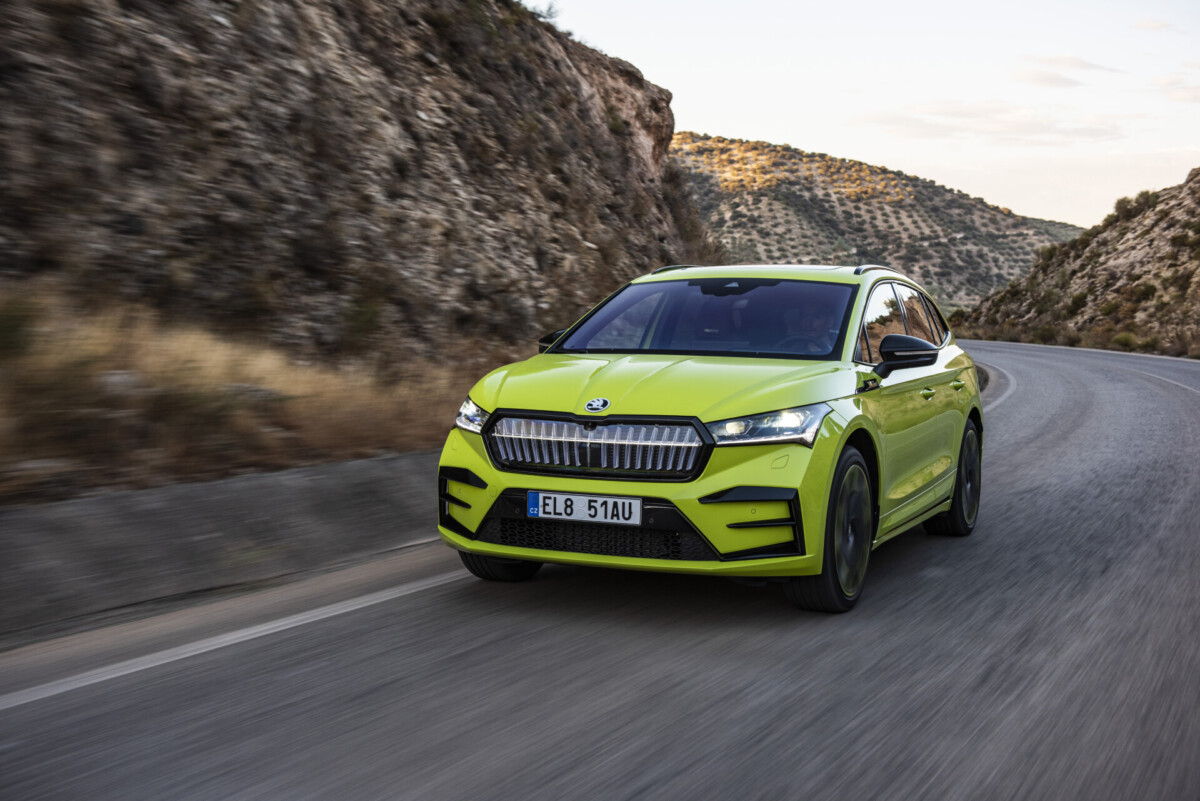
The compromise between comfort and dynamism is adequate, nothing more. Our test model was equipped with the DCC with adaptive suspensions allowing to adjust different driving modes. In “Comfort” mode, it’s obviously comfortable despite the large 21-inch rims, but the problem is that even in “Sport” mode, it doesn’t change much.
The body roll is always marked, especially during a little hard braking, while on a series of fast turns, the front axle is quickly lost. The management, artificially firm, does not really contribute to the dynamism. You will have understood it, even if, in terms of comfort, the Enyaq RS remains good in all situations, in terms of sportiness, this is not a panacea. Too bad for a model badged RS.
Regarding regenerative braking, it can be activated in two ways. First via the central selector with mode “B”, which allows you to benefit from a greater engine braking effect, but also with the paddles behind the steering wheel, again to modify the regenerative braking power, without that you can stop completely like on other electric models with one-pedal driving. It’s a shame, but it’s unfortunately commonplace on all Volkswagen Group electric cars.
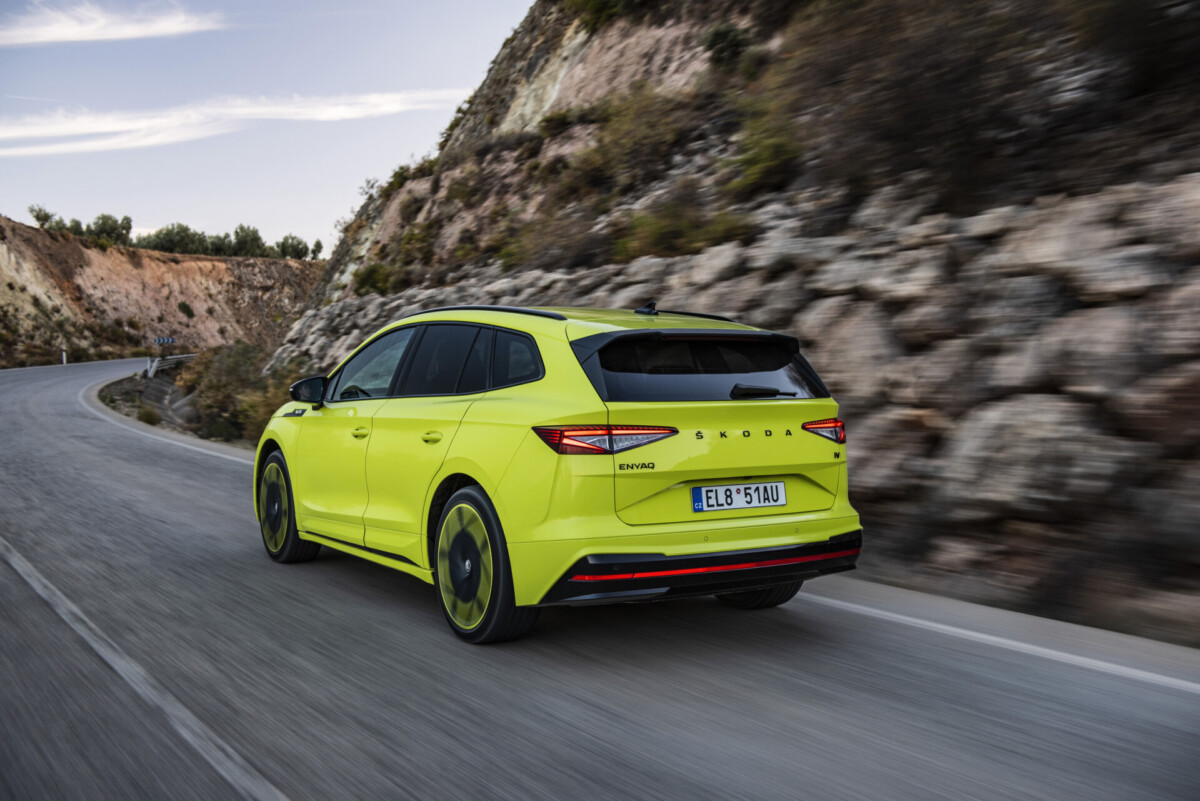
Autonomy, battery and charging
The Skoda Enyaq RS iV is equipped with the largest battery in the range, namely that of 82 kWh (77 kWh net) enabling it to claim 494km autonomy according to the WLTP cycle, i.e. 10 km less than the Coupé version. Charging power is limited to 135kW in direct current.
Technically, difficult to go beyond for the Enyaq, since the MEB platform on which it is based embeds a 400 shutter architecture and not 800 volts. To increase the charging power, we will have to wait for the future SSP platform, which should make it possible to double this value thanks to a new 800-volt architecture. But obviously, given what Volkswagen recently announced, the next generation will surely start on an MEB-Evo still limited to 400 volts and not on the SSP.
Skoda announces a charge from 10 to 80% in 36 minutes and a recovery of 100 km of autonomy in six minutes by falling to a battery level of 5%. We wanted to experiment with recharging on a Spanish Ionity terminal with the new Plug & Charge function (the terminal recognizes the car directly and avoids badgering), but unfortunately our test turned out to be unsuccessful since the terminal did not wanted to work.
During our test in Spain, not far from Malaga, we noted an average consumption of 19.5 kWh / 100 kmwhich, compared to 77 kWh, would make a range of just over 400 km for a trip that mixed the highway and the departmental. Skoda announces for its part 16.7 kWh / 100 km in the combined cycle.
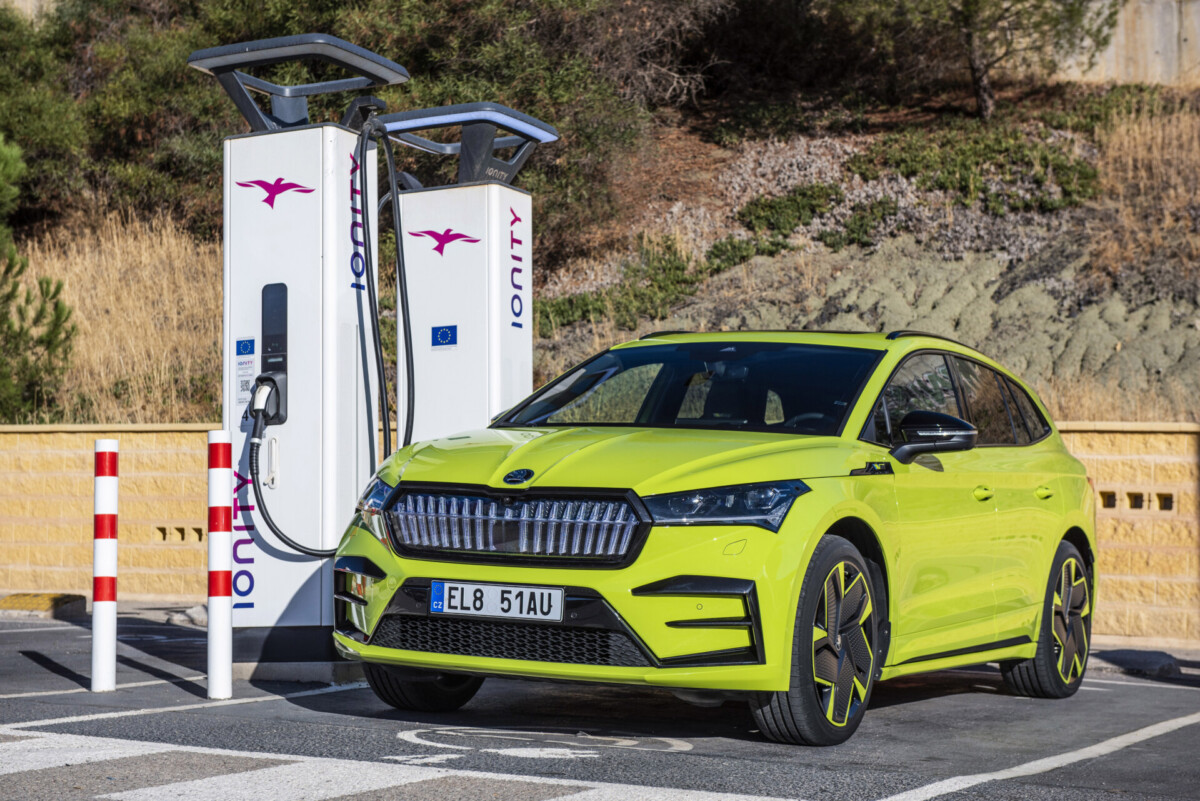
Price, competition and availability
If the Enyaq range starts from 44,580 euros, our RS trial version is sold for its part from €61,130. All models, with the exception of the RS version which exceed the threshold of 60,000 euros, are eligible for the ecological bonus. The first deliveries will begin in early 2023.
In front of it, we therefore find the Volkswagen ID.4 GTX, whose technical data sheet and positioning are similar with 60,650 euros, as well as the Tesla Model Y and the 64,990 euros claimed in the Long Autonomy version. We can also mention the Volvo XC40 Recharge, the Kia EV6 or the Enyaq in the 80X version which will perhaps be its biggest competitor.
